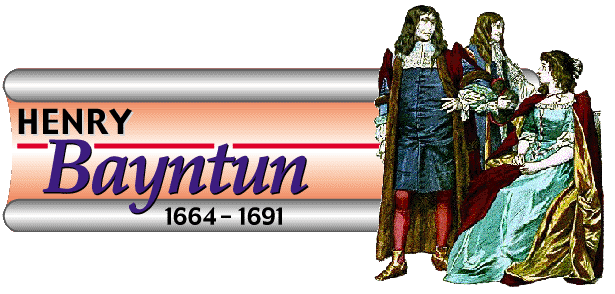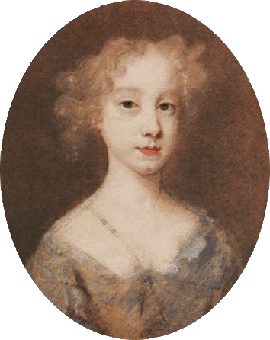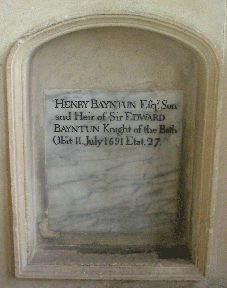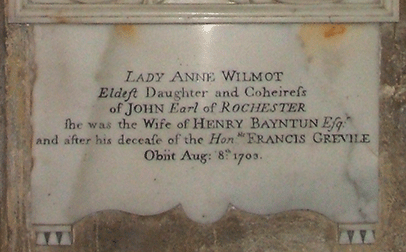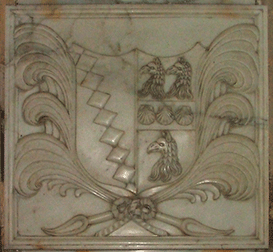|
Married:
LADY ANNE WILMOT
The eldest daughter and co-heiress of John Wilmot,
2nd Earl of Rochester and his wife, Elizabeth Mallet,
the heiress of the ancient family of John Mallet of Enmore.
This marriage took place on 21st July 1685
at Adderbury, Co. Oxon.
Children:
JOHN BAYNTUN
(Son and heir 1688-1716)
EDWARD (15/10/1686 - 7/2/1687)
ANNE (1689 - 1734)
Lady
Anne Wilmot (pictured right)
|
|

Henry Bayntun
was born at Spye
Park House, Bromham in the county of Wiltshire
and was baptised on 17th November 1664. He inherited the Manor of
Bromham after the death of his father Sir Edward Bayntun in 1679 when
he was 15 years old and was brought up, with his brother and sister,
under the guardianship of George Johnson MP for Bowden Park. His mother, Stuarta
Thynne, nor any of her relations were forbidden to intermeddle with
her children's education or estate by the terms of her husband's will,
dated some nine years before his death.
On 12th June
1674, a marriage contract was made between Henry Bayntun (then aged
10) and Lady Sophia, the daughter of Thomas Osborne, the Earl of
Danby, Lord High Treasurer of England, with the consent of the parents
on both sides. Later that month in a letter to Bridget Osborne,
the Countess of Danby, Henry's father wrote of his son's good fortune
to draw the hand of her pretty daughter, the Lady Sophia, for his
valentine. In 1678, Henry
left England with his tutor, Dr. Brunnel and travelled abroad. A
Licence to Henry Bayntun and Dr. Brunnel was granted at Whitehall
to travel beyond the sea for three years. However while he was overseas,
his father died and Henry returned in 1679 and subsequently the
marriage contract to Lady Sophia never took effect.
Henry Bayntun maintained the family tradition of firm protestantism and also that
of representing Wiltshire Boroughs (Calne and Chippenham) in Parliament
but time had changed and he was a sound Tory in contrast to his father
and grandfather. He owned a very considerable estate and was made
a Justice of the Peace while still in his teens and became acquainted
at the Court of Charles II and was a Member of Parliament for Chippenham
shortly before he became of age in 1685-1687 and a Member for Calne
1689-1690.
He served in
Parliament with his uncle, Nicholas Bayntun and after six successive
generations of his family in politics, he was the last of the direct
line of Bayntun family to sit in Parliament. He was also Free Burgess
of Devizes 1682-1684 and from May 1689 until his death. Thomas Dingley
was in the Wiltshire area making sketches of the various great houses
and on May 1st 1684 he made one of Spye Park House.
Around this time Henry was in possession of:
1684 – THE MANOR AND LORDSHIP OF HINTON
Including the Priory at Hinton and another famous estate attached,
known as "The Grange of Hinton Charterhouse",
and the lands surrounding it, which was contemporary with the Carthusian
Monastery, founded in 1227. In 1700 Henry's widow sold all the Grange
estate and the Charterhouse to Mr. John Harding of Broughton Gifford.
She sold the Manor of Hinton to William Chanler of Warminster also
at this time.
1684 – COPPICE LYING IN OR NEAR FARLEIGH
This was, at the time, a large wood, since converted into farmland
– part of which was called Castle Farm.
1684 – THE MANOR OF TELLISFORD
The messuages, farm, or demesne of Tellisford, with the advowson of
the Church.
1684 – THE MANOR OF WEEKE
Including Wick Farm, or West Wick, lying in the parishes of Hinton,
Norton and Farleigh.
1684 – HINTON WOODS
Containing 400 acres.
1684 – THE MANOR OF ROWLEY
Situated in Somerset and Wiltshire. This Manor was also sold to William
Chanler of Warminster in 1700 by Henry Bayntun's trustees.
1684 – THE MANOR OF RODE AND LANGHAM
With the advowson of the Church of Rode.
1684 – THE MANOR AND LORDSHIP OF ST. PHILLIPS
1684 – THE MANOR OF WELLOW AND TWINHOE
With the Rectory or Parsonage there and all tithes, Glebe thereunto
belonging.
Until his death
on the 11th July 1680, John Wilmot, the 2nd Earl of Rochester and
a prominent figure at the Court of Charles II, was a frequent visitor
to the Bayntun mansion at Spye Park. John Wilmot was a member of
the House of Lords at the age of just 20, the King's Gentleman of
the Bedchamber and one of the best-known of the libertine set linked
with the Restoration Court. He had distinguished
himself of Oxford and wrote many poems, satirical verse, plays and
criticisms on everything around him, thereby making many enemies.
He was renowned for his drunkenness and extravagant frolics, engaging
in notorious affairs with both court women and common prostitutes
before he eventually died, in agony, from a syphilis related illness aged only
33
Henry Bayntun became
acquainted with Wilmot's daughter –
the Right Honourable Lady Ann Wilmot, of St. Martin's in the Fields,
Middlesex, a noted beauty and heir of her father. Anne was the eldest of four children born to Elizabeth Mallet, Countess of Rocheste and her early childhood was spent largely at her parents Oxfordshire home at Adderbury and her mother’s property at Enmore in Somerset. It was at Adderbury that Anne married her first husband Henry Baynton on the 21st July 1685. Henry, the son of a family friend, was 21 and Anne was 18. Anne was a good catch and along with her two younger sisters she was co-heiress to her late brother’s estate and brought land valued at £21,000 to the marriage. Both of her parents were dead at
the time and she was at the disposing of the Countess Dowager of Rochester,
her grandmother and guardian, who consented to the marriage.
In a settlement,
dated a week before their wedding, Lady Anne Wilmot agreed to levy a fine and settle her lands
on Henry, and the issue of the marriage, her lands being valued
at £21,000. Henry, at the time confirmed the
article by an endorsement and afterwards a settlement was made by
Henry, which was approved by her grandmother, the Countess of Rochester.
Though the jointure was near £1,900 per annum the lands upon
the issue male did not hold out to be £1,500 per annum and
the greater part of that too in reversion. Having bought Hinton Priory around this time also, Henry was looking out for more property in the area. in particular those owned by the Hungerford family. Whenever any
of these Hungerford lands came under the hammer they were bought up
by Henry Bayntun of Spye Park – this was known as "The
Great Sale".
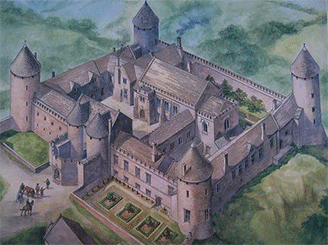
|
The last Sir
Edward Hungerford of Farleigh Castle, best known as "Hungerford
the Waster," was one of the least worthy members of the court
of Charles II, and spent most of his time entertaining. He gave £500
for a wig to which he had taken a particular affection to and is said
to have gambled away in succession, 28 manors. He is also said to
have paid £30,000 across the green cloth and was eventually
forced to sell most of the Hungerford lands, having wasted £80,000
capital and £14,000 a year.
Hungerford's prized possession was the ancient castle known as Farleigh Hungerford and when Henry Bayntun had the option to buy this famous landmark and subsequent lands, he wasted no time and by 1689 he was the owner of the Manor of Farleigh Hungerford and various other lands from Sir Edward Hungerford. In the early years
of its occupation, Farleigh Castle is described as almost unchanged
from the time of the old English Barons, but by 1701 a long process
of decay had begun to take its toll. |
For all this Henry contracted to give the sum of £56,000. £10,000
was to be retained in his hands and to be paid to Lady Mackareene
at the time specified in her marriage article of 1664, viz, after
the death of Sir Edward Hungerford. Henry borrowed £30,000 from
the Hon. John of Hartwell, George Hadley of Eats Barnet, Sir John
Poultney of the Inner Temple and Sir John Foche of Clapham. A bundle of deeds,
first dated 1689, held in the Somerset Records Office confirms this
and mentions Henry Bayntun, with his address listed as Farleigh Castle,
in relation to a piece of land and a cottage in Monkley Lane, Rode
Common which he sold to Robert Cox, clothier, of Westbury, Wiltshire.
The family moved into Farleigh Castle and Henry and his wife, Anne, are said to have used it as their principal residence for two years, but the dream came crashing down about their ears. Henry died suddenly on July 11, 1691 in his 27th year, following a short illness and was buried the same day in the crypt at St Nicholas’ Church, Bromham. His will, written shortly before his death devised most of the Hungerford estates to his executors Sir Edward Warneford and Walter Grubbe, to be sold to clear these debts. Prior to his
death, Henry Bayntun sold the famous Coaching Inn called Beckhampton
House, previously known to locals as 'Catharine Wheel', which
was formerly part of Brinsden or Brundsen Farm, Avebury. It was purchased
by William Norris (then of the Middle Temple) some time in 1691 and
the property was mortgaged at that time by Robert Bayntun of Avebury.
In purchasing
Sir Edward Hungerford's estate and Farley Castle, Henry had become
greatly indebted and had mortgaged some of the estates so purchased,
and also his own Manors of Bremhill and Bromham, for £42,000
and being indebted to the petitioners £22,000 by bonds, judgments,
etc., devised the Hungerford estates to Sir Edmond Warneford and
Walter Grubbe in his will dated June 1691, to be sold for payment
of his debts and left the said Manors of Bremhill and Bromham to
his son and heir, John Bayntun, subject to the payment of his debts
and legacies.
The rents and
profits of the said manors at the time of Henry's death were not
sufficient to pay the interest of the said mortgage money, by £1,000
per annum. The Hungerford lands, when sold, would be sufficient
to discharge the debts with a surplus for his son, which otherwise
would be swallowed up and the creditors unsatisfied. All of his great purchases were funded by debt, had he lived long enough to pay off his debts, his strategy might have been successful.
At the time of his death, Henry was just 26 years of age and his children, Anne (aged
2) and her brother John (aged 3) were placed under the guardianship
of Mr. Walter Grubbe Esq. of Eastwell House, Potterne, M.P. for Devizes.
Following the death of their mother in 1703, Mr. Grubbe, as guardian
of these friendless children, took them under his charge and they
were brought up at Eastwell, where the accounts for their clothing
and education are still preserved. Eastwell House, the long time home
of the Hunt-Grubbe family is early 16th century, but was almost completely
rebuilt in 1772.
The Grubbe family
were one of the largest land owners in the district and are descended
from a Danish family, the first of whom to settle in England was Thomas
Le Grubbe who had a chateau at Dover in 1306. A Robert Grubbe lived
at Devizes where he died in 1499 and a Henry Grubbe was Mayor of Devizes
in 1568 and a Member for Parliament for Devizes in 1577.
After Bayntun's
death, a Bill was brought by the creditors of Henry against his widow,
his infant son and heir and trustees, to have the lands sold for payment
of debts, complaining it was obstructed by Lady Anne, setting up so
many pretended claims by the marriage agreements, etc. She disclosed
the articles and the settlements made and the deficiency thereof in
point of value. Despite his debts Henry had settled his widow with
a £3,000 jointure and bequeath £4,000 to his youngest sister sister Lucy.
A petition for
a Private Bill to secure a portion for his daughter and establish
a trust for his only son, a minor, was presented on the 10th December
1692, and despite a petition against it from his widow and young son,
it duly passed. Farleigh Castle and other properties were devised
to his executors, Walter Grubbe and Sir Edmond Warneford. These properties
were eventually sold to repay interest on loans running to £1,000
per annum. The Countess
of Rochester, on behalf of her great-grandson John, the heir of Henry
Bayntun, filed a cross-bill to have the defect in value supplied,
which was dismissed without costs.
Henry Bayntun's
will also specified that should his son die without a male heir then
his remaining estate was to descend to his daughter Anne, on the condition
that she married a Bayntun 'kindred of the fourth degree' or
that her husband assume the Bayntun name.
1691 – MESSUAGES OF HUNGERFORDS
With lands and rights for fishing etc. in Fox, Milford, Freshford,
Westwood, Bradford, Bradford Leigh, Wingfield, Woolverton. The lands
in Freshford, Bradford and Westwood were sold in 1700 by Henry's widow
to William Chanler of Warminster.
1691 – THE ADVOWSON OF THE CHURCH OF FARLEIGH
1691 –
THE MANOR OF ILFORD
Including the farm and demesne, situated in Somerset and Wiltshire.
Henry Bayntun devised this land on trust for sale and in 1700 his
trustees sold the Manor to William Chanler of Warminster.
The Manor of
Enmore was held by a long line of Malet descendants from as far back
as 1166. Following the death of Anne Wilmot's mother, Elizabeth Malet
in 1682, the manor was held in trust until 1691 before being passed
onto Lady Anne, when she was 24 years of age. She died in 1703, but
the manor remained in the Bayntun family until 1751 when Sir Edward
Bayntun Rolt broke up the estate and sold the manor to John Perceval,
the Earl of Egmont.
1700 –
THE MANOR OF FARLEIGH HUNGERFORD
Including Farleigh Castle and the Park. The Castle and Castle Yard
at Farleigh – were sold by Henry Bayntun's widow sometime between 1700-1702
to Hector Cooper some years later, but it was not until the year 1730,
that it was re-sold to Joseph Houlton, by Thomas Cooper, the brother
and heir of Hector. Henry Bayntun was to receive, during his life,
£500 a year out of the estate, being in interest of 5% on the
£10,000 payable at his death. The different purchasers at Bayntun's
death had therefore to pay annually their proportion of this annuity.
The Master in Chancery appointed to manage the sale was Dr. Edisburg.
The sale appears to have been constructed, not by public auction but
by private biddings to the Master. The competitors for Farleigh were
Hector Cooper of Trowbridge, and Joseph Houlton. Esq. (who married
the heiress of the Grittleton Estate).
Anne had the income from her mother’s estate at Enmore, which she inherited when she was 24, bit it was far from plain sailing thereon in. Anne was forced to sell most of the remaining Hungerford estates. In the years
1700-1702, Henry's widow sold most of the Hungerford estates, including
the manoral lands of Farleigh to Joseph Houlton. Farleigh Castle and
park was sold separately to Hector Cooper of Trowbridge and sadly
from that time onwards, the historical Farleigh Hungerford Castle went into decay. Langenham Mill
and some land about it was sold to John George alias Edwards of Worton
in the parish of Potterne and the Manor of Rode was also sold at this
time.
It was imperative that Anne remarry, and quickly, but she chose her new husband carefully, marrying Francis Greville, MP for Warwick, on January 26, 1693. Francis was the son and heir of Fulke Greville, 5th Baron Brooke of Beauchamp’s Court, and herein lies yet another connection to Anne’s St John ancestry the Hon. Francis Greville, the Earl of Warwick on the 26th January 1693, but Anne also died suddenly
in 1703, aged 36 years and her body was laid to rest beside her husband's in the Bayntun family crypt beneath the Bayntun Chapel in Bromham Church, Wiltshire.
